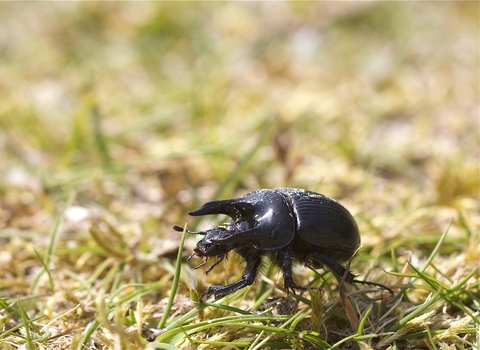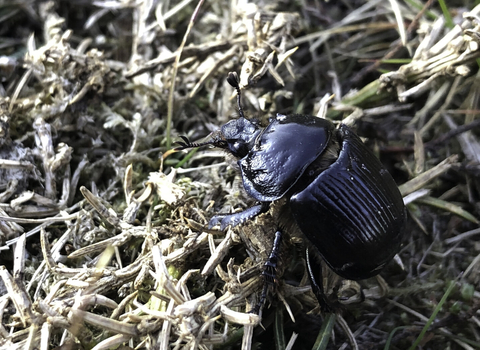
Male minotaur beetle ©Ian A Kirk

Female minotaur beetle © Tom Hibbert
Minotaur beetle
Named for its three bull-like horns, the minotaur beetle is a large dung beetle found on grassland and heathland. Adults drag dung back to their nests for their larvae to feed on.
Enw gwyddonol
Typhaeus typhoeusPryd i'w gweld
September to JulySpecies information
Category
Ystadegau
Length: up to 2cmCommon.
Ynghylch
The minotaur beetle is a large, round dung beetle found on sandy grassland and heathland, where it feeds on rabbit droppings and other dung, often at night. Adults emerge in autumn, but still need to mature in order to breed, so undergo an intense feeding period. If the weather is mild, they may start breeding in early winter.They nest in tunnels that can be up to 1.5 metres deep, where they lay their eggs and provide dung for the larvae to feed on; they drag the dung back to their nest using their strong front legs. The males use their 'horns' to defend the nest. By the following summer, their cycle is completed and the adults will die to make way for the next generation.
Sut i'w hadnabod
The minotaur beetle is glossy black, with ridges running down the wing cases. Males are unmistakeable, sporting three 'horns' (two long horns and one short one in the centre) on their thorax. Females lack the horns but have pointed edges on the front corners of their pronotum (the plate-like structure that covers the thorax).Dosbarthiad
Widespread, but scarce, in England and Wales.Roeddech chi yn gwybod?
The minotaur beetle is one of a number of dung beetles in the UK that bury balls of dung for their larvae to feed on. These beetles provide a vital nutrient-recycling service for our habitats.Gwyliwch
Female minotaur beetle (https://vimeo.com/552475647)
Female minotaur beetle (c) Tom Hibbert
